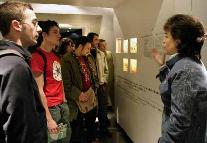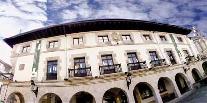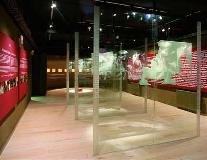EUROPE
The Gernika Peace Museum (Spain)
(April 24, 2008)
by Iratxe Momoitio, Director
The Gernika Peace Museum seeks to promote a culture of peace. Its founding was inspired by the tragic bombing of the city of Gernika in April 1937, during the Spanish Civil War, by German aircraft in support of General Francisco Franco.
The museum opened on April 7, 1998 as the Gernika Museum, focusing on the history of Gernika and the bombing, then changed to the Gernika Peace Museum in 2002 and become the first peace museum in Spain.
The Gernika Peace Museum does not intend to act as a narrator of war stories. It is, rather, a space which helps us to believe in peace, invites us to seek out peace, observe peace, and confront it. It is a theme museum conveying a culture of peace, transmitting the ideas and sensations of interaction between history, creativity, and human emotions.
The permanent exhibition of the museum is founded upon three main questions:
“What is peace?” A wide selection of ideas, concepts, thoughts, and points of view in relation to peace are presented.
“What is the legacy of the bombing of Gernika?” The history of Gernika and the Spanish Civil War, the bombing of Gernika, and the lesson of peace taught by the survivors of this tragic event through their reconciliation with their attackers.
“What about peace in the world today?” A look at the world through Picasso’s “Guernica” using Human Rights and the Basque conflict as prisms to study the current state of peace in the world today.
The museum compares and proposes a number of universal aspects in relation to peace. From an absence of peace when human rights are violated, to the presence of peace when, after the conflict, comes reconciliation or the right-thinking ideas of the world’s pacifists.
The permanent exhibition of the museum is somewhat unusual in that the objects and artifacts are not the primary focus. The emphasis of the museum is on the senses, on the mind and heart, and two powerful audiovisual presentations are geared to move visitors in this way. The first provides the visceral experience of being in a house at the time of the Gernika bombing while the second shares the post-conflict reconciliation processes involving adversaries in such locations as Gernika-Germany, Northern Ireland, and South Africa.
In addition, the Gernika Peace Museum organizes a range of temporary exhibitions, either prepared by the museum or brought in from other institutions, such as “Hiroshima-Nagasaki” and “Art and Human Rights.”
An active educational department also prepares materials and workshops about the permanent or temporary exhibitions to work with children, families, and groups of adults.
Address: Foru Plaza 1, 48300 Gernika-Lumo, Bizkaia, Basque Country, Spain
Tel: +34-94-627-02-13
Homepage: http://www.peacemuseumguernica.org
Days closed: January 1, 5, 6; May 1; November 1; December 24, 25
Admission: Admission: € 4 for regular admission; € 2 for students, seniors, unemployed;
free admission for children under 13 years old and ICOM members;
free admission on the first Sunday of the month and other special days
(Originally published on April 7, 2008)
 The Gernika Peace Museum |  Exterior of the Gernika Peace Museum. |  A look at the world through Picasso’s “Guernica.” |
 Peace Museums of EUROPE
Peace Museums of EUROPE